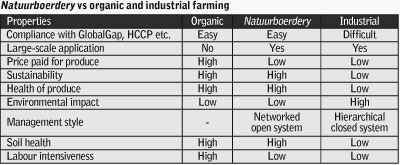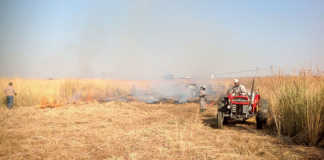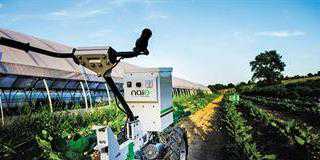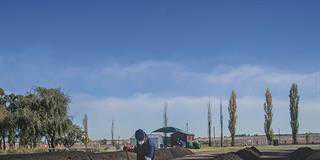
Limpopo farming conglomerate ZZ2 is well known for its large-scale production of tomatoes, onions, avocados, apples and pears. In the late 1990s, the operation faced declining yields, increasingly expensive pest and disease control measures, and escalating pesticide and fertiliser costs. At the same time, it became aware of growing consumer demand for food produced in an environmentally-friendly manner.
ZZ2 realised it needed a mind shift, and sought the advice of the late Freek Engelbrecht, professor of philosophy at the University of the North, and entomologist Professor Erik Holm. The pair helped the conglomerate convert from a conventional production system predominantly reliant on chemical fertiliser and pesticides to more ecologically-balanced production.
Over time, these changes developed into an entirely new approach to farming at ZZ2, one which CEO Tommie van Zyl named natuurboerdery (nature farming). “We needed to switch to an ‘open system’ that reacts to change,” explains Holm. “The term natuurboerdery has natural ecosystems and processes in mind.” Natuurboerdery allows ZZ2 to use the best technology in harmony with natural forces and ecosystem laws.
“ZZ2 did not turn to organic production but chose to develop an approach that incorporates organic materials with reduced use of inorganic fertiliser and pesticides,” explains Holm. “This strategy lends itself to cost-effective, large-scale application, leading to sustainable farming and nutritious produce. The concept lies between organic and industrial farming, but is better than either.”
Natuurboerdery has five guidelines: agro-ecosystem health, soil health, plant health, food health and human health. It incorporates the use of inorganic fertiliser and organic soil amendments such as compost teas and raw manure for soil health and plant nutrition, and inorganic pesticides, biological control agents and fermented plant extracts for pest control.
After 12 years, the conversion to natuurboerdery put into practice by ZZ2 has led to numerous changes and benefits, the results of which ZZ2 is not shy to share.
“Many farmers worldwide are searching for a more sustainable way of farming,” says Holm. “Farm land is getting scarcer. Countries are facing the challenge of urban sprawl, mining and water depletion. In the long term, we believe farming this way will be cheaper because we protect our soil, while industrial farming will become more expensive.” The most significant benefits of the natuurboerdery approach are improved soil health, with higher levels of organic matter and soil microbial activity, and higher yields.

Compost tea
One of the most successful experiments was to use compost and compost tea, a process which now underpins production on the farm. ZZ2 makes 20 000t of compost annually, part of which is used to brew 2,2 million litres of compost tea. “Introducing compost was an excellent move,” explains Holm. “In 2002, we applied compost at around 2 000kg/ ha. This increased to 9 000kg/ ha in 2010. Compost tea application increased from about 50l/ha in 2003 to 1 300l/ ha in 2010.
As a result, soil organic matter and soil microbial activity is now far higher, making nutrients more readily available to the crop. We brought in experts from the US and Israel to advise us on optimal recipes and processes.” The tea is brewed in batches, each containing 40kg of mature compost, 1l Afrikelp and 1kg each of brown sugar, Seagro and humate in 1 000l water.
The water is oxygenated by bubbling air through it for 24 hours before adding the ingredients, and for another 72 hours afterwards. The tea is used within six hours, and applied weekly through drip irrigation or as a foliar spray. When sprayed, it helps to control leaf and fruit diseases and has been effective, for example, in replacing copper oxychloride as a fungicide for avocados.
Pest and disease management
Holm stresses that one has to be “wide awake and intelligent” when it comes to insect control in natuurboerdery. A team of trained scouts inspect the crops daily for pests and diseases, counting insects in traps and examining individual plants. Biocontrol agents are used to control insect pests: Copidosoma in the case of bollworm eggs, Trichograma and Encarsia wasp for whitefly eggs and Digyphylus for aphids.
Should these fail to suppress the pests to acceptable levels, fermented plant extracts with insecticidal properties are used. Plant protection does not exclude the use of chemical pesticides, but the least toxic pesticide is tried first. This approach has seen a significant reduction in the use of chemical pesticides and each production unit is also expected to show a year-on-year reduction in pesticide use.
Not all ZZ2’s experiments have been successful. Some experiments, such as cutting down on pesticides too rapidly and using huge quantities of raw manure (between 4 000kg/ha and 6 000kg/ ha from 2006 to 2008), are thought to have lowered yields. There is also a question mark over the impact of the programme on soil structure, as the structure of soil in the tomato lands is still deteriorating.
“But that is the way we learn,” says Holm. “ZZ2 is conducting experiments on 2 000ha and sometimes it pays massively for mistakes. But if we get the formula right, then we’re way ahead. The lessons we’ve learned are to optimise compost quality and quantity, optimise soil health for long- term sustainability, optimise planting times, and optimise pesticide applications and integrated pest management.”
Quality, not quantity
ZZ2 has proved that eco-agriculture is practical on a commercial scale. But the key is to manage fruit quality. “Chasing quantity will never work with nature-friendly farming,“ Holm emphasises. “If a farmer produces half the quantity but gets a higher quality product – in terms of nutrient value and beauty – he can earn the same turnover. This is good news for the small-scale farmer.”
Still, farmers are bound to mass produce to supply food for the ever-increasing population. “The only way to achieve sustainability is to adapt,” says Holm. “Natuurboerdery can work, but it’s evolving. We don’t have all the answers, but we’re trying extremely hard.”
Additional source: An investigation of Natuurboerdery approach: a ZZ2 case study, (2011) by Silent Taurayi, Faculty of Economic and Management Sciences, Stellenbosch University.
Contact Erik Holm on 083 461 7629 or email [email protected]













